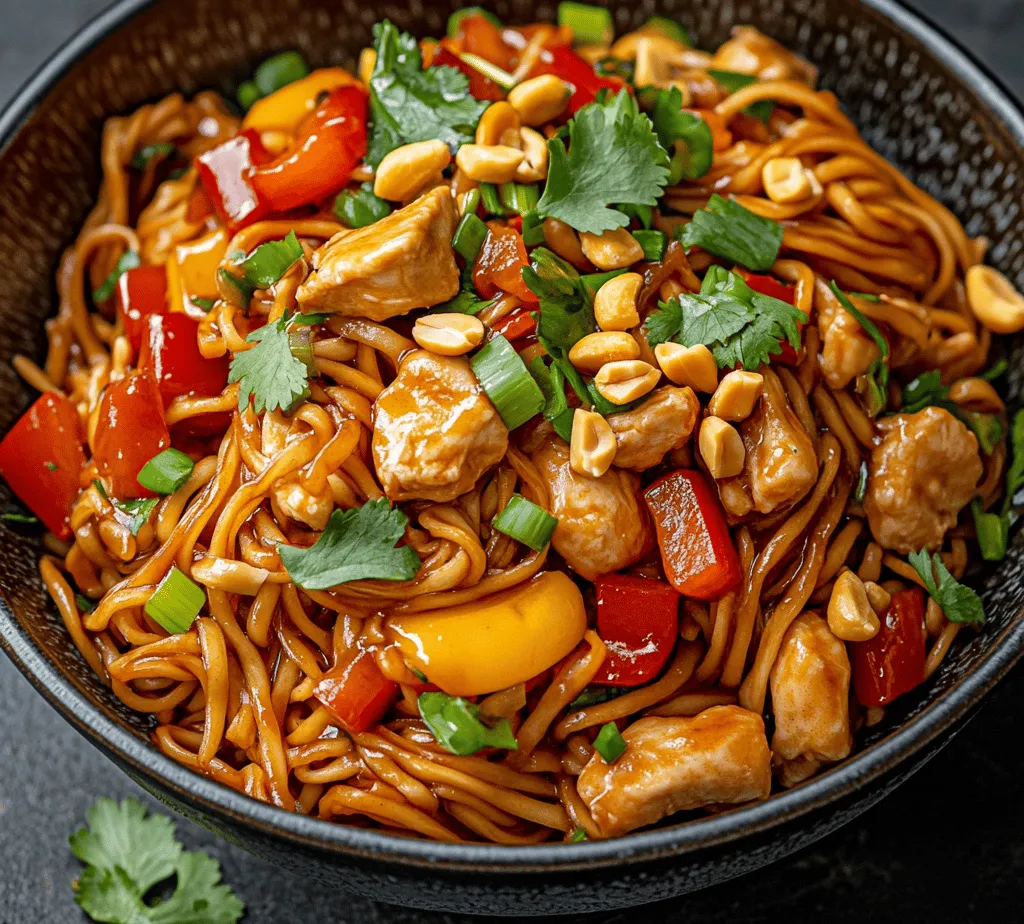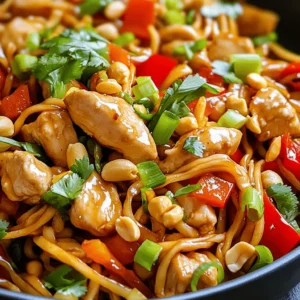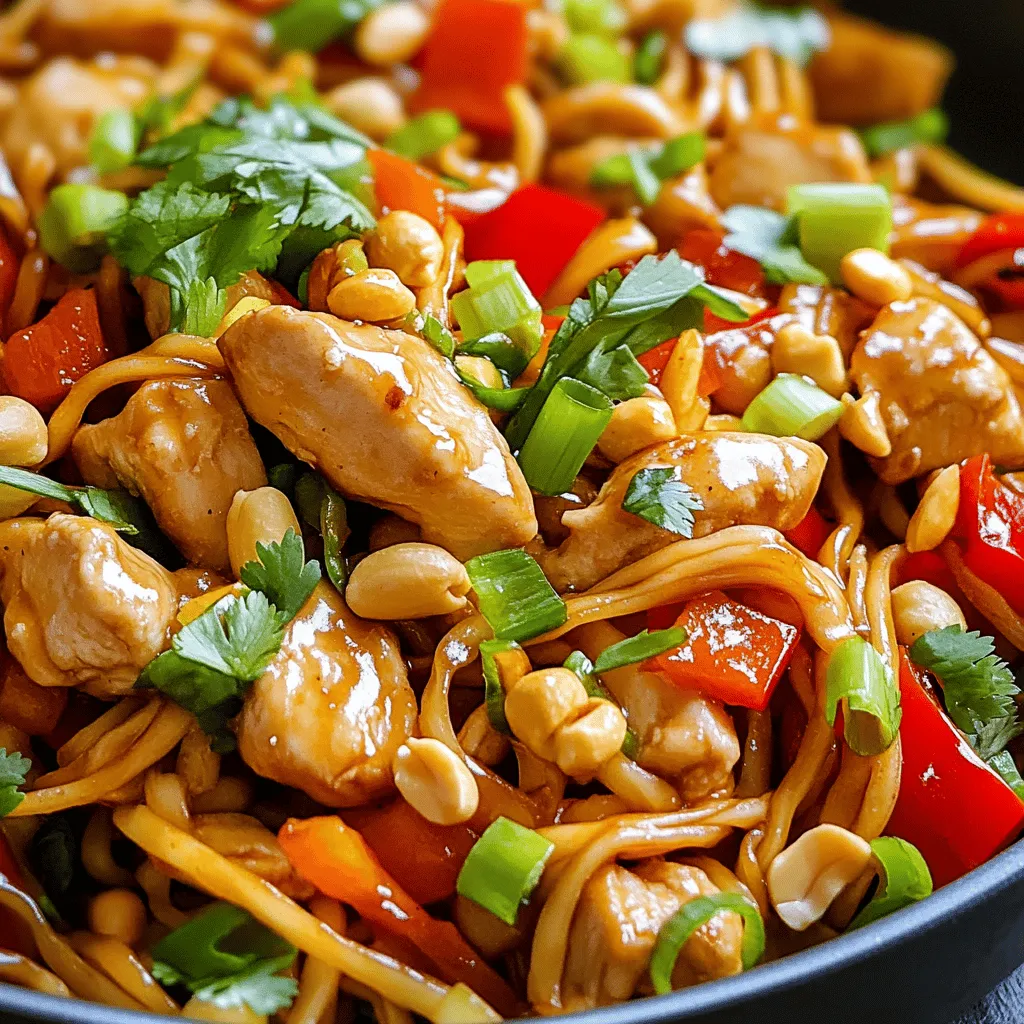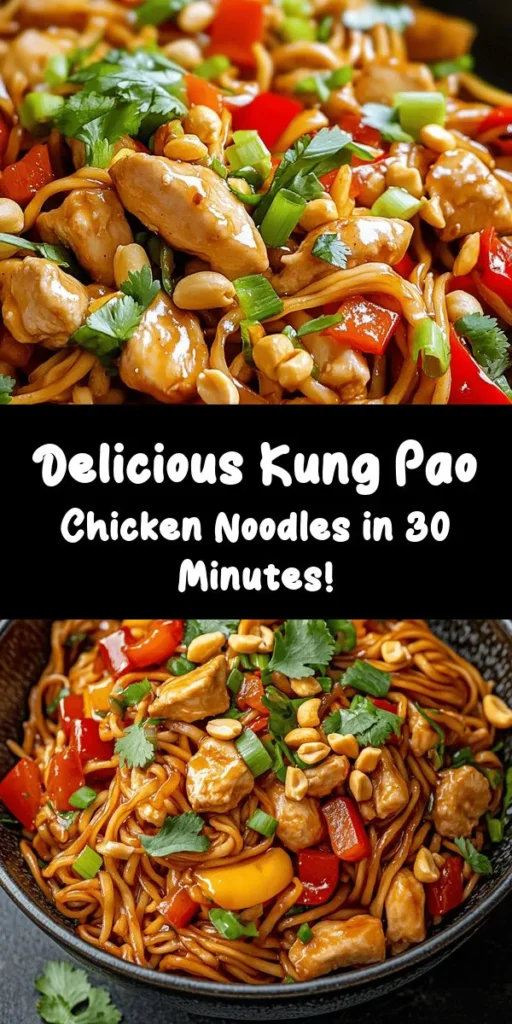Introduction
Kung Pao Chicken Noodles is a delightful dish that has captured the hearts of food enthusiasts around the world. Originating from the Sichuan province of China, this dish combines the rich and bold flavors of traditional Kung Pao Chicken with the comforting texture of noodles, creating a satisfying meal that appeals to both Asian and Western palates. The harmony of taste, texture, and aroma makes Kung Pao Chicken Noodles not just a dish, but an experience.
Traditionally, Kung Pao Chicken is known for its tender chicken pieces stir-fried with a medley of vegetables, peanuts, and a spicy-sweet sauce that tantalizes the taste buds. When noodles are introduced into this mix, it elevates the dish by adding a chewy texture and heartiness that makes it perfect for a quick weeknight dinner or a more elaborate gathering. This fusion of flavors and ingredients creates a well-balanced meal that is nutritious and delicious, making Kung Pao Chicken Noodles a perennial favorite.
The Allure of Kung Pao Chicken Noodles
Kung Pao Chicken is not just a popular dish in Chinese cuisine; it is a cultural icon that tells a story of heritage and culinary evolution. Historically, the dish is named after Ding Baozhen, a Qing dynasty official known as “Kung Pao.” It was originally prepared with diced chicken, peanuts, and vegetables, and often featured a spicy kick from Sichuan peppercorns. Over the years, as Chinese cuisine has spread globally, it has adapted to local tastes and ingredient availability, leading to the creation of variations like Kung Pao Chicken Noodles.
In its noodle form, the dish has undergone a transformation that appeals to a wider audience. The addition of egg noodles provides a comforting base that complements the savory and spicy elements of the Kung Pao sauce. This modern interpretation retains the essence of the original dish while offering a familiar comfort food experience. The result is a perfect balance of flavors: the savory notes from soy sauce, the sweetness from sugar, and the heat from chili paste create a symphony of tastes that dance on the palate.
Ingredient Breakdown
To craft the perfect bowl of Kung Pao Chicken Noodles, it’s essential to understand the role each ingredient plays in contributing to the dish’s overall flavor and texture. Below is a breakdown of the key components that will make your Kung Pao Chicken Noodles truly exceptional.
Egg Noodles
Egg noodles are a staple in many Asian dishes, and they serve as the perfect foundation for Kung Pao Chicken Noodles. Made from wheat flour and eggs, these noodles have a rich, slightly chewy texture that can hold up well to stir-frying. Their ability to absorb sauces while maintaining structure ensures that each bite is packed with flavor. When cooked correctly, egg noodles provide a satisfying mouthfeel that complements the tender pieces of chicken and crunchy vegetables, enhancing the overall dining experience.
Chicken Breast
Using boneless, skinless chicken breast is crucial for this dish. Chicken breast is lean and cooks quickly, making it an ideal choice for stir-frying. The uniformity of the chicken allows for even cooking, resulting in tender pieces that soak up the flavors of the accompanying sauces. Additionally, chicken breast is a blank canvas that easily absorbs the seasonings and spices used in the Kung Pao sauce, ensuring that every bite bursts with flavor.
Sauces and Seasonings
The sauces and seasonings are the heart of Kung Pao Chicken Noodles, providing depth and complexity to the dish. Here are the key ingredients that create the signature Kung Pao flavor profile:
– Soy Sauce: This umami-packed sauce is a staple in Asian cooking. It adds saltiness and depth to the dish, enhancing the flavors of the chicken and vegetables.
– Rice Vinegar: With its mild acidity, rice vinegar balances the dish’s flavors and adds a slight tang that brightens the overall taste profile.
– Hoisin Sauce: This sweet and savory sauce contributes a rich, complex flavor that complements the other ingredients. It adds a unique depth that elevates the dish beyond ordinary stir-fries.
– Sugar: A touch of sugar is essential to achieve the right balance of savory and sweet, harmonizing with the spiciness of the dish.
Each of these ingredients plays a crucial role in the overall flavor of Kung Pao Chicken Noodles, creating a sauce that is both multilayered and addictive.
Vegetables
Fresh vegetables not only enhance the nutritional value of the dish but also add vibrant colors and textures. In Kung Pao Chicken Noodles, the following vegetables are commonly used:
– Bell Peppers: These colorful veggies add a sweet crunch and are rich in vitamins A and C. They also bring a delightful freshness to the dish.
– Zucchini: When sliced thinly, zucchini cooks quickly and adds a subtle flavor that blends well with the other ingredients. It is also low in calories but high in nutrients, making it a great addition.
Incorporating a variety of vegetables ensures that each bite is filled with different textures and tastes, making the dish more appealing and satisfying.
Peanuts and Garnishes
Roasted peanuts are a hallmark of Kung Pao Chicken and play a vital role in adding crunch and richness to the dish. Their nutty flavor contrasts beautifully with the tender chicken and fresh vegetables, providing a delightful textural element that enhances the overall experience.
To finish off the dish, garnishing with fresh cilantro and sliced green onions not only adds a pop of color but also contributes a burst of freshness. Cilantro brings a herby note that brightens the dish, while green onions add a mild onion flavor that ties everything together.
Step-by-Step Cooking Instructions
Now that you have a clear understanding of the ingredients and their significance, it’s time to dive into the cooking process. Follow these step-by-step instructions to create your own delicious Kung Pao Chicken Noodles at home.
1. Prepare the Ingredients: Begin by gathering all the ingredients listed. Chop the chicken into bite-sized pieces and marinate it with soy sauce, cornstarch, and a dash of rice vinegar for about 15 minutes. This will ensure the chicken becomes flavorful and tender.
2. Cook the Noodles: In a pot of boiling water, cook the egg noodles according to the package instructions until they are al dente. Drain and set aside, tossing them with a bit of oil to prevent sticking.
3. Stir-Fry the Chicken: In a hot wok or large skillet, add a tablespoon of oil and let it heat up. Once hot, add the marinated chicken and stir-fry until it is golden brown and cooked through, about 5-7 minutes. Remove the chicken from the pan and set it aside.
4. Sauté the Vegetables: In the same wok, add a bit more oil if necessary and toss in the bell peppers and zucchini. Stir-fry for about 3-4 minutes until they are tender-crisp. Add minced garlic and ginger for extra flavor, cooking for an additional minute until fragrant.
5. Combine Everything: Return the cooked chicken to the wok with the vegetables. Add the cooked egg noodles, hoisin sauce, sugar, and rice vinegar. Toss everything together until the noodles are coated in the sauce and heated through.
6. Finish with Peanuts and Garnishes: Just before serving, stir in the roasted peanuts. Plate the dish and garnish with chopped cilantro and green onions for a fresh finish.
With these steps, you’ll have a colorful and flavorful bowl of Kung Pao Chicken Noodles ready to enjoy! The combination of tender chicken, fresh vegetables, and that signature sauce creates a meal that is not only satisfying but also quick to prepare, making it perfect for busy weeknights or special occasions.
As you embark on this culinary journey, embrace the flavors and textures that Kung Pao Chicken Noodles have to offer, and enjoy the delightful fusion of cultures that this dish represents.

Cooking the Noodles
To start, prepare the noodles as the base of this delightful Kung Pao Chicken Noodles dish. The key to achieving the right texture lies in the quality of your noodles and the method of cooking them. Begin by filling a large pot with water and adding a generous amount of salt—about 1 tablespoon for every 4 quarts of water. This step not only enhances the flavor of the noodles but also helps them retain their structure during cooking.
Bring the salted water to a rolling boil. Once boiling, add your noodles. It’s essential to cook them al dente, which means they should be firm to the bite but not overly soft. This texture will hold up well when mixed with the other ingredients later. Refer to the package instructions for the recommended cooking time, typically ranging from 3 to 7 minutes depending on the type of noodles used. Stir occasionally to prevent sticking, and once they are cooked to your liking, drain the noodles in a colander and rinse them briefly under cold water to stop the cooking process. This technique will also help remove excess starch, ensuring your noodles remain separate and don’t clump together.
Preparing the Sauce
The sauce is what brings Kung Pao Chicken Noodles to life, and achieving the perfect consistency and flavor balance is crucial. In a medium bowl, whisk together soy sauce, rice vinegar, hoisin sauce, and a touch of sesame oil. For added depth, consider including a spoonful of sugar or honey to balance the salty and tangy flavors.
To achieve a desirable thickness in your sauce, cornstarch is your best friend. Mix 1 tablespoon of cornstarch with 2 tablespoons of water to create a slurry, which will help thicken the sauce as it cooks. Make sure to adjust the flavors according to your taste. If you prefer a spicier kick, you can add crushed red pepper flakes or a dash of sriracha. Taste the sauce before cooking it to ensure it meets your flavor profile, as this will be the backbone of your dish.
Cooking the Chicken
When it comes to cooking the chicken, the technique you choose can greatly influence the final outcome. Start with boneless, skinless chicken breasts or thighs, cut into bite-sized pieces. For optimal browning and flavor, make sure your pan is hot before adding the chicken. Use a wok or a large skillet, and heat a couple of tablespoons of vegetable oil over medium-high heat until shimmering.
Add the chicken pieces in a single layer, ensuring they are not overcrowded. This step is vital for achieving that desired golden-brown color and a slightly crispy texture. Cook the chicken for about 5-7 minutes, flipping occasionally until it’s fully cooked and no longer pink in the center. To keep the chicken juicy, avoid overcooking. Once done, remove the chicken from the pan and set it aside while you prepare the vegetables.
Stir-Frying Vegetables
Stir-frying is an essential technique in Asian cuisine that allows vegetables to retain their vibrant color, crisp texture, and nutritional value. For this recipe, select a colorful mix of bell peppers, zucchini, and snap peas. You can also add diced onions and garlic for extra flavor.
Before adding the vegetables to the pan, make sure it is still hot. Add a tablespoon of oil, then toss in the vegetables. Stir-fry for 3-4 minutes until they are just tender but still crunchy. Be mindful not to overcook them, as you want to maintain their freshness and bright colors. If using tougher vegetables like carrots, consider slicing them thinly or blanching them briefly before adding them to the mix.
Combining Ingredients
Once your chicken and vegetables are cooked, it’s time to bring everything together. In the same pan, add the chicken back to the stir-fried vegetables. Pour your prepared sauce over the mixture, stirring well to coat all the ingredients evenly. The heat will activate the cornstarch in your sauce, allowing it to thicken as it cooks.
Next, add the cooked noodles to the pan, using tongs to gently toss everything together. This technique will ensure that the noodles absorb the flavors of the sauce and the other ingredients. Cook for an additional 2-3 minutes, just long enough to heat through and allow the flavors to meld.
Final Touches
To elevate your dish, finish with a sprinkle of finely chopped green onions and a few roasted peanuts for added crunch. These final touches not only enhance the presentation but also provide contrasting textures and flavors that make the dish more appealing. Serve your Kung Pao Chicken Noodles hot for the best experience, as the flavors are most vibrant when fresh from the stove.
Nutritional Information
Kung Pao Chicken Noodles are not only delicious but also nutrition-packed. This dish offers a balanced blend of protein from the chicken, carbohydrates from the noodles, and vitamins and minerals from the assorted vegetables.
On average, a single serving of Kung Pao Chicken Noodles contains approximately 450-500 calories, making it a hearty meal without being overly indulgent. You can expect to find essential nutrients such as:
– Protein: Approximately 30 grams, which is vital for muscle repair and growth.
– Fiber: Around 4-5 grams, primarily from the vegetables, aiding in digestion.
– Vitamins: A good source of Vitamin A from bell peppers and Vitamin C from broccoli or snap peas.
– Minerals: Contains iron and potassium, important for various bodily functions.
These nutritional benefits make Kung Pao Chicken Noodles a wholesome choice for any meal.
Serving Suggestions
For a complete dining experience, consider pairing your Kung Pao Chicken Noodles with side dishes that complement the flavors. Here are a few ideas:
1. Cucumber Salad: A refreshing cucumber salad dressed with rice vinegar and sesame oil can offer a cool contrast to the warm, spicy noodles.
2. Spring Rolls: Light and crispy vegetable spring rolls can be a delightful appetizer that balances the meal.
3. Steamed Broccoli: Simple steamed broccoli provides a nutritious side that adds color to your plate.
Beverage pairings can further enhance your meal. Opt for a chilled jasmine tea to cleanse the palate or a light lager beer if you prefer something with a bit of fizz.
Variations and Customizations
Kung Pao Chicken Noodles are incredibly versatile, allowing for various adaptations based on dietary preferences. For a vegetarian version, substitute the chicken with tofu or tempeh, which can absorb the flavors of the sauce beautifully.
If you’re looking for a gluten-free option, use gluten-free noodles and ensure that the soy sauce is made from tamari rather than traditional soy sauce.
You can also experiment with different proteins, such as shrimp or beef, or incorporate seasonal vegetables like bok choy, carrots, or mushrooms for added flavor and texture. Adjust the level of spice according to your preference by varying the amount of chili sauce or adding fresh chili peppers.
Conclusion
Kung Pao Chicken Noodles stand out as a delicious, nutritious, and versatile dish that perfectly balances flavor and texture. With its blend of tender chicken, vibrant vegetables, and satisfying noodles, this recipe is sure to delight your taste buds and impress your family.
Encouraging you to try making this dish at home, it offers an excellent opportunity to explore your culinary skills while enjoying a meal that is both satisfying and health-conscious. The balance of flavors—sweet, savory, and spicy—combined with the ease of preparation makes Kung Pao Chicken Noodles a go-to option for any night of the week. Dive into this delightful recipe and savor the experience of home-cooked goodness!



